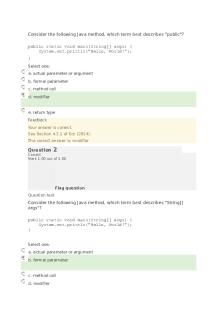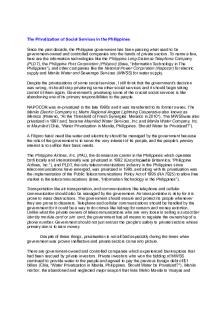Consider the impacts of the Exxon Valdez oil spill in Alaska PDF

| Title | Consider the impacts of the Exxon Valdez oil spill in Alaska |
|---|---|
| Author | omoye osebor |
| Course | Geography |
| Institution | Nottingham Trent University |
| Pages | 4 |
| File Size | 87 KB |
| File Type | |
| Total Downloads | 62 |
| Total Views | 127 |
Summary
Case study of Exxon Valdez spill in Alaska ...
Description
Consider the impacts of the Exxon Valdez oil spill in Alaska When did it happen? On March 24, 1989, the tanker Exxon Valdez, en route from Valdez, Alaska to Los Angeles, California, ran aground on Bligh Reef in Prince William Sound, Alaska. The vessel was traveling outside normal shipping lanes in an attempt to avoid ice. Within six hours of the grounding, the Exxon Valdez spilled approximately 10.9 million gallons of its 53 million gallon cargo of Prudhoe Bay crude oil. Eight of the eleven tanks on board were damaged. The oil would eventually impact over 1,100 miles of non-continuous coastline in Alaska, making the Exxon Valdez the largest oil spill to date in U.S. waters. Why did it happen? Multiple factors have been identified as contributing to the incident. Beginning three days after the vessel grounded, a storm pushed large quantities of fresh oil on to the rocky shores of many of the beaches in the Knight Island chain. [14] In this photograph, pooled black oil is shown stranded in the rocks.
Exxon Shipping Company failed to supervise the master and provide a rested and sufficient crew for Exxon Valdez. The National Transportation Safety Board found this was widespread throughout the industry, prompting a safety recommendation to Exxon and to the industry. [15] The third mate failed to properly maneuver the vessel, possibly due to fatigue or excessive workload.[15] Exxon Shipping Company failed to properly maintain the Raytheon Collision Avoidance radar, which, if functional, would have indicated to the third mate an impending collision with the Bligh Reef by detecting the "radar reflector", placed on the next rock inland from Bligh Reef for the purpose of keeping boats on course via radar. [16]
Captain Joseph Hazelwood, who was widely reported to have been drinking heavily that night, was not at the controls when the ship struck the reef. However, as the senior officer, he was in command of the ship even though he was asleep in his bunk. In light of the other findings, investigative reporter Greg Palast stated in 2008, "Forget the drunken skipper fable. As to Captain Joe Hazelwood, he was below decks, sleeping off his bender. At the helm, the third mate never would have collided with Bligh Reef had he looked at his RAYCAS radar. But the radar was not turned on. In fact, the tanker's radar was left broken and disabled for more than a year before the disaster, and Exxon management knew it. It was [in Exxon's view] just too expensive to fix and operate." [17] Exxon blamed Captain Hazelwood for the grounding of the tanker. [16] Other factors, according to an MIT course entitled "Software System Safety" by Professor Nancy G. Leveson, [18] included: 1. Tanker crews were not told that the previous practice of the Coast Guard tracking ships out to Bligh Reef had ceased. [19]
2. The oil industry promised, but never installed, state-of-the-art iceberg monitoring equipment.[20] 3. Exxon Valdez was sailing outside the normal sea lane to avoid small icebergs thought to be in the area.[20] 4. The 1989 tanker crew was half the size of the 1977 crew, worked 12–14 hour shifts, plus overtime. The crew was rushing to leave Valdez with a load of oil.[21] 5. Coast Guard tanker inspections in Valdez were not done, and the number of staff was reduced. [21] 6. Lack of available equipment and personnel hampered the spill cleanup. [19] This disaster resulted in International Maritime Organization introducing comprehensive marine pollution prevention rules through various conventions. The rules were ratified by member countries and, under International Ship Management rules, the ships are being operated with a common objective of "safer ships and cleaner oceans". What were the impacts of this oil spill? Both the long-term and short-term effects of the oil spill have been studied. Immediate effects included the deaths of 100,000 to as many as 250,000 seabirds, at least 2,800 sea otters, approximately 12 river otters, 300 harbor seals, 247 Bald Eagles, and 22 orcas, and an unknown number of salmon and herring. The effects of the spill continued to be felt for many years afterwards. As of 2010 there were an estimated 23,000 US gallons of Valdez crude oil still in Alaska's sand and soil, breaking down at a rate estimated at less than 4% per year. Overall reductions in population were seen in various ocean animals, including stunted growth in pink salmon populations. The effect on salmon and other prey populations in turn adversely affected killer whales in Prince William Sound and Alaska's Kenai Fjords region. Sea otters and ducks also showed higher death rates in following years, partially because they ingested prey from contaminated soil and from ingestion of oil residues on hair due to grooming. The spill had both short-term and long-term economic effects. These included the loss of recreational sports, fisheries, reduced tourism, and an estimate of what economists call "existence value", which is the value to the public of a pristine Prince William Sound. The economy of the city of Cordova, Alaska was adversely affected after the spill damaged stocks of salmon and herring in the area. 1. Recreational Sport Fishing Losses. This loss was estimated based on the impacts of the spill on sport fishing activity. One must consider the impact on the number of anglers, the number of sport fishing trips, the areas fished, the species fished for, and the length of these trips. For 1989 the loss was estimated to be between $0 and $580 million dollars; for 1990 the range was $3.6 million $50.5 million dollars. 2. Tourism Losses. The spill caused both negative and positive effects. The major negative effects were: 1. Decreased resident and non-resident vacation/pleasure visitor traffic in the spill-affected areas due to lack of available visitor services (accommodations, charter boats, air taxis).
2. Severe labour shortage in the visitor industry throughout the state due to traditional service industry workers seeking high-paying spill clean-up jobs. 3. Fifty-nine percent of businesses in the most affected areas reported spill-related cancellations and 16% reported business was less than expected due to the spill. 3. Replacement costs of birds and mammals. These costs include the relocation, replacement and rehabilitation for some of the shorebirds, seabirds and the marine and terrestrial mammals that may have suffered injury or were destroyed in the Exxon Valdez oil spill. The values range from $20,000 to $300,000 dollars per marine mammal (sea otters, whales, sea lions, seals), $125 to $500 dollars per terrestrial animal (bears, river otters, mink, deer), and $170 to $6,000 dollars for seabirds and eagles.
Oil Spill Facts
The amount of oil spilled could fill 125 Olympic-sized swimming pools. As many as 2,800 sea otters, 300 harbor seals, 900 bald eagles and 250,000 seabirds died in the days following the disaster. 1,300 miles of coastline were hit by the oil spill.
1,000 harlequin ducks were killed by the oil spill, in addition to many chronic injuries that occurred as a result of the long term effects of the spill.
The cleanup required about 10,000 workers, 1,000 boats and roughly 100 airplanes and helicopters.
Four deaths were directly associated with cleanup efforts.
The spill caused over $300 million of economic harm to more than 32 thousand people whose livelihoods depended on commercial fishing.
Tourism spending decreased by eight percent in south central Alaska and by 35 percent in southwest Alaska in the year after the spill.
There was a loss of 9,400 visitors and $5.5 million in state spending.
Many fish populations were harmed during the spill. For example, sand lance populations went down in 1989 and 1990, herring returns were significantly fewer in 1992 and 1994 and adult fish had high rates of viral infections.
Pink salmon embryos continued to be harmed and killed by oil that remained on stones and gravel of stream banks through at least 1993. As a result, the southwestern part of Prince William Sound lost 1.9 million or 28 percent of its potential stock of wild pink salmon. By 1992, this part of the
sound still had 6 percent less of the wild pink salmon stock than was estimated to have existed if the spill had not occurred.
Two years following the Exxon Valdez spill, the economic losses to recreational fishing were estimated to be $31 million.
Twelve years after the spill, oil could still be found on half of the 91 randomly selected beaches surveyed.
Three species of cormorant, the common loon, the harbor seal, the harlequin duck, the pacific herring and the pigeon guillemot still have not fully recovered....
Similar Free PDFs

BP oil spill - it is an essay
- 7 Pages

Lecture 20 - The Oil Industry
- 3 Pages
Popular Institutions
- Tinajero National High School - Annex
- Politeknik Caltex Riau
- Yokohama City University
- SGT University
- University of Al-Qadisiyah
- Divine Word College of Vigan
- Techniek College Rotterdam
- Universidade de Santiago
- Universiti Teknologi MARA Cawangan Johor Kampus Pasir Gudang
- Poltekkes Kemenkes Yogyakarta
- Baguio City National High School
- Colegio san marcos
- preparatoria uno
- Centro de Bachillerato Tecnológico Industrial y de Servicios No. 107
- Dalian Maritime University
- Quang Trung Secondary School
- Colegio Tecnológico en Informática
- Corporación Regional de Educación Superior
- Grupo CEDVA
- Dar Al Uloom University
- Centro de Estudios Preuniversitarios de la Universidad Nacional de Ingeniería
- 上智大学
- Aakash International School, Nuna Majara
- San Felipe Neri Catholic School
- Kang Chiao International School - New Taipei City
- Misamis Occidental National High School
- Institución Educativa Escuela Normal Juan Ladrilleros
- Kolehiyo ng Pantukan
- Batanes State College
- Instituto Continental
- Sekolah Menengah Kejuruan Kesehatan Kaltara (Tarakan)
- Colegio de La Inmaculada Concepcion - Cebu













